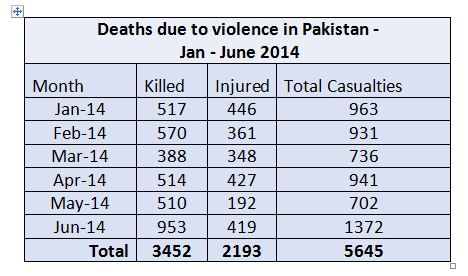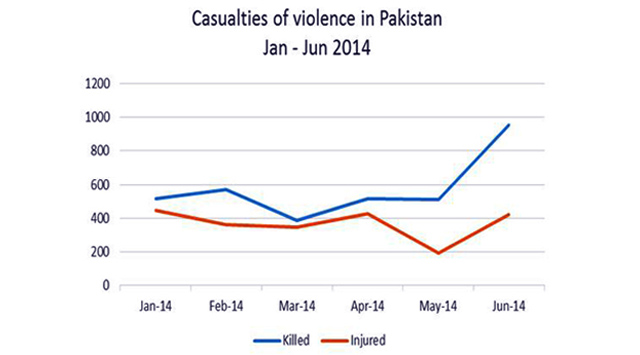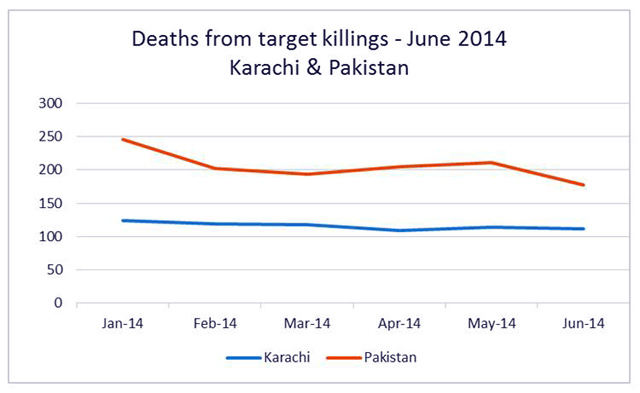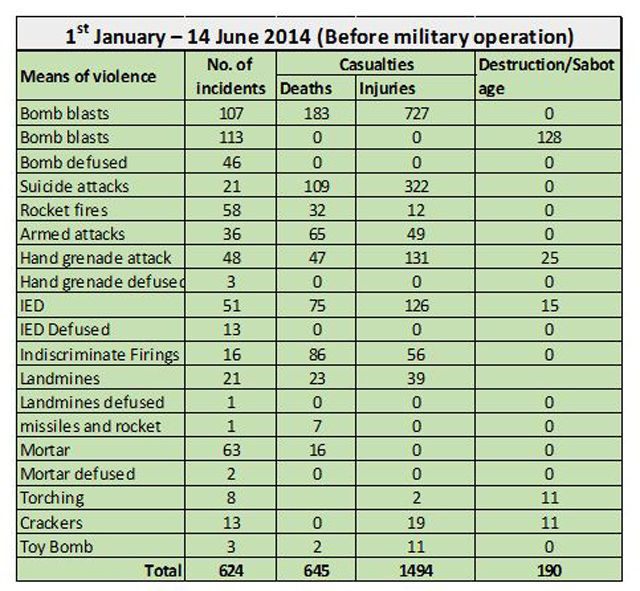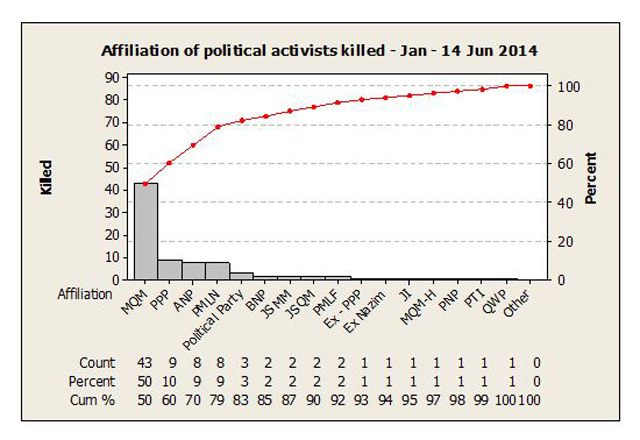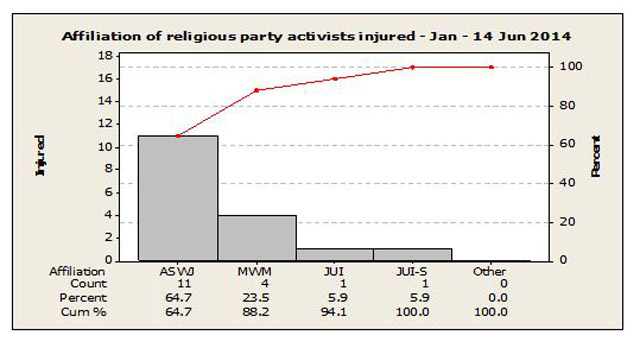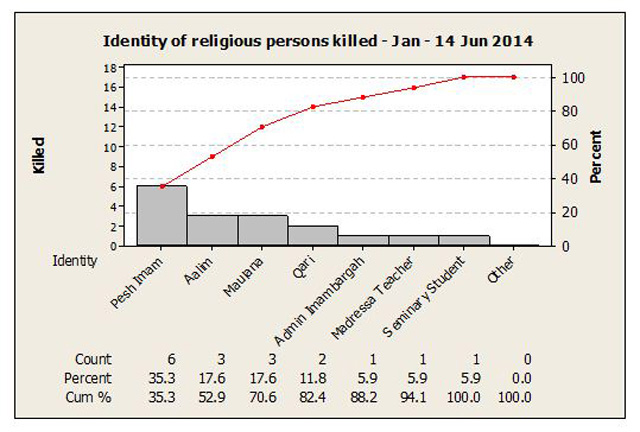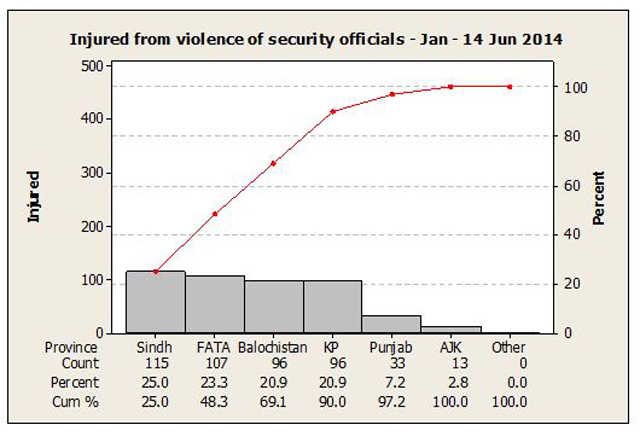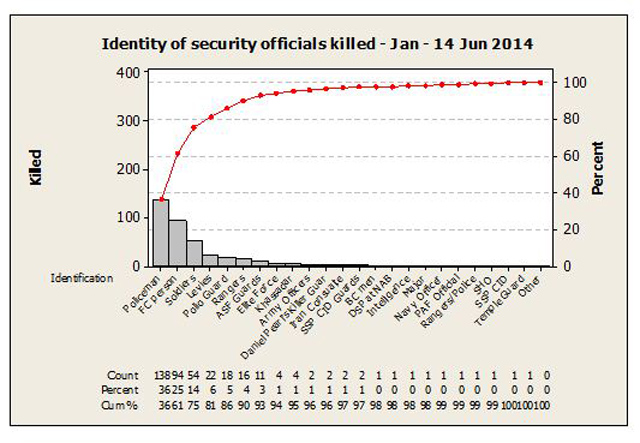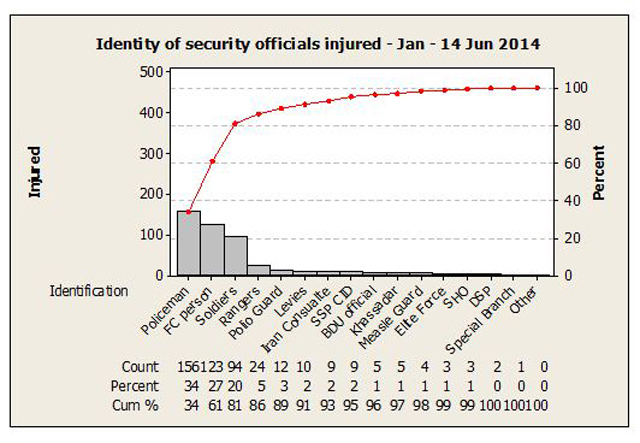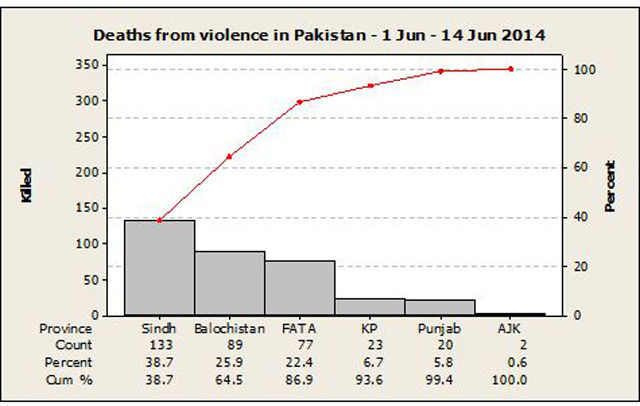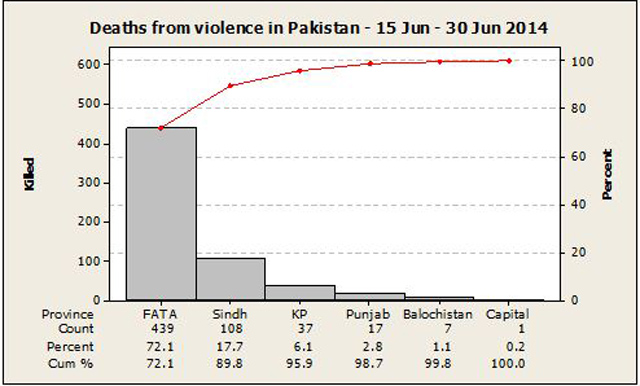This report mainly covers the following topics:
- Deaths due to violence in the country during June 2014
- Military operation Zarb-e-Azb
- Means of violence before the military operation
- Sabotage incidents during the year before military operation
- Deaths of prominent civilians before military operation
- Deaths of political party activists before military operation
- Deaths of religious party activists before military operation
- Deaths of religious persons before military operation
- Desecration of worship places before military operation
- Casualties of security officials before military operation
- Means of violence that killed the security officials before military operation
- Claimants of attacks on security officials
- Deaths from violence before and after military operation
- Victims of violence before and after military operation
- Victims of sectarian violence before and after military operation
- Methods of violence before and after military operation
The Center for Research and Security Studies (CRSS) will appreciate comments from the readers on this report.
Report prepared by:
Mohammad Nafees
Senior Research Fellow
Center for Research and Security Studies
NOTE: Readers can approach CRSS for source of any information included in the report. Please send your request to: [info@crss.pk] or mohammad.nafees@yahoo.com.
OVERVIEW
Deaths due to violence in the country during June 2014:
As many as 1,400 people (953 dead and 419 wounded) fell victims to violence and counter-terror operations in the month of June, taking the total number of violence-related casualties for the year to 5,645 (Refer to table 1 and graph 1). This represents an over 10% decrease in violence-related casualties. In the period between January-June 2013, some 3317 were killed.
It should be noted that no major security operation in Karachi or NWA was going on during that period.
Table 1: Deaths from violence in Pakistan –June 2014
Graph 1: Deaths from violence in Pakistan – June 2014:
During the month of June, FATA region once again topped the list of regions that lost people to the ongoing wave of violence and war against militancy, insurgency, and criminal gangs in the country. Over 50% of fatalities in the country were recorded in FATA during this month and its basic cause was the ongoing military operation in North Waziristan (Refer graph 2). This marked a 150% rise in the number of fatalities in June.
Graph 2: Number of people killed in provinces due to violence:
Unlike previous months, target killings ranked second to the security operation as a cause of human losses during this month. In May, target killings’ share in the countrywide fatalities was 40% which declined to about 18% in June. Nationally, crime rate fell by over 20% but no change took place in Karachi, based on the data we collected (Refer graph 3).
Graph 3: Deaths from target killings in June (Karachi & Pakistan):
While the fatalities of civilians went up 25% during the month of June, the hardest hit were the militants whose casualties shot up by about 250%. The losses of human lives (security and government officials) also increased by about 25% while the numbers of politicians, criminals, and religious persons dropped noticeably (Refer table 2).
Table 2: Victims of violence in Pakistan – Jan – Jun 2014
Military operation Zarb-e-Azb:
On June 15 2014, Pakistan army launched an operation in North Waziristan to clear the area from the militants. The decision was probably prompted by the brazen terrorist attack on Karachi Airport on 10th June 2014 that left 38 persons dead and over 13 persons injured besides burning down of a cargo section. All political parties supported the operation with Pakistan Tehreek-e-Insaaf (PTI) voicing its displeasure for not keeping it in the loop before launching the operation.
Although it is too early to make any assessment of the operation, a brief review of the incidents of militancy before and after the operation may be of interest to the readers of this report. First, we will take a look at the nature of threat faced by the country before the military operation.
Means of violence before the military operation:
In the first five and half months (1 Jan – 14 Jun 2014), there were 624 incidents of violence and sabotage activities that involved bomb blasts, suicide attacks, rocket fires, armed attacks, hand grenade attacks, IED explosions, indiscriminate firings, landmines, mortar attacks, torching, cracker and toy bomb explosions (Refer to table 3).
Table 3: Means of violence used before military operation:
The above table covers mostly the deadliest and highly destructive forms of violence that, on an average, almost occurred four times a day in the country during this period. This figure will rise manifold if other forms of violence like gunning down, dead bodies, forced abduction, and slaughtered dead bodies were added to it. The casualties from the violence listed in the above table were 2,139 (645 deaths, 1,494 wounded), meaning 13 persons were either died or injured every day during the period under review.
Sabotage incidents during the year before military operation:
A review of sabotage incidents during the year (from 1 January to 14 June 2014) draws a very dismal picture of a situation where terrorism appears to have one and the only agenda – destroy everything that exists in the country. The following is the list of destruction by the terrorist activities in the country. Militants tried to attack the following places using bomb, hand grenade, rocket, and mortar shell:
Houses = 60
Check post = 28
Gas Pipelines = 32
School = 23
Polio Team abduction = 12
Measles Team abduction= 16
Mortar fell on Village = 15
Tribesmen abduction = 11 (Gunmen abducted tribesmen from Badabher, Peshawar)
Vehicles destruction = 12
NATO Container = 8
Railway track = 8
Mosque = 8
Hujra = 7
Police Station = 6
Roadside Bomb blast = 6
Shop = 5
Hi power Xmission = 5
Open fields = 4
Sufi shrine = 4
Peshawar Airport = 4 Rocket attacks (2 near the airport, and 2 on the runway)
Bridge = 3 (1 bridge was blown up, 2 attempts to blow bridges failed)
Karachi Airport = 1 38 dead, 13 injured, and the cargo section was put on fire
Deaths of prominent civilians before military operation:
Doctors = 10
Bank Managers = 3
Businessmen = 6
Director (Insurance Company) = 1
Educationists = 12
Social Activist = 1
Polio team members killed = 7
Polio team members injured = 6
Tribesmen killed = 40
Tribesmen injured = 13
Tribal Peace volunteers killed = 50
Tribal Peace volunteers injured = 13
Lawyers = 11
Judge = 1
Director Agriculture Dept injured= 1
Deaths of political party activists before military operation:
Number of political party activists killed = 91
All mainstream political parties had their activists and supporters killed before the military began its operation in the North Waziristan.The MQM had the highest number of its activists killed during this period followed by PPP, ANP, and PMLN respectively. There were other local parties that also lost their activists (Refer to graph 4).
Graph 4: Affiliation of political activists killed before military operation:
Deaths of religious party activists before military operation:
Religious party activists killed = 51
Religious party activists injured = 17
Religious parties also lost their activists and the highest among them were from the Ahl-e-Sunnat Wal-Jamaat (ASWJ) followed by Sunni Tehreek (ST), Majlis-e-Wahdatul Muslimeen (MWM), Jamiat Ulema-e-Islam-Sami (JUI-S) and others (Refer graphs 5 and 6).
Graph 5: Affiliation of religious party activists killed before military operation:
Graph 6: Affiliation of religious party activists injured before military operation:
Deaths of religious persons before military operation:
Religious persons = 17
Even religious persons were not spared by the criminals as during this period 17 of them lost their lives to different kinds of violence in the country (Refer graph 7)
Graph 7: Identity of religious persons killed before military operation:
Desecration of worship places before military operation:
Desecration of worship places = 19
Religious hatred led the people to commit acts of blasphemy without getting apprehended for such an unholy crime. Throughout the country 19, worship places became target of religious zealots instigated by unverified accusation of act of sacrilege committed against their respective belief. There were some cases of desecration that were committed by the militants when they placed bombs near a mosque or fired rockets that landed near a mosque. From mosque to temple and Imam Bargah to Sufi shrine, no worship place remained safe from the act of desecration during the period under review (Refer graph 8).
Graph 8: Desecration of worship places before military operation:
Casualties of security officials before military operation:
No. of security officials died = 379
No. of security officials injured = 460
Data suggests that security forces suffered more than two a day casualties during the period from 1 January to 14 June 2014. The highest number of casualties of security officials was noted in Sindh followed by FATA, KP, Balochistan, Punjab, AJK, and Capital (Refer graphs 9 and 10).
Graph 9: Deaths from violence of security officials before military operation:
Graph 10: Injured from violence of security officials before military operation:
Among the security officials, the number of policemen was the highest in in terms of both – death and injuries. Following them were the FC personnel, soldiers, levies, polio guards, rangers and many others (Refer graphs 11 & 12).
Graph 11: Identity of security official killed before military operation:
Graph 12: Identity of security official injured before military operation:
Means of violence that killed the security officials before military operation:
Means of violence Deaths
Gunned down = 115
IED explosion = 54
Bomb blasts = 42
Encounters = 34
Armed attacks = 33
Beheading = 23
Indiscriminate firings = 16
Clash = 11
Hand grenade attacks = 7
Landmines = 5
Rocket attacks = 4
Ground operation = 1
Claimants of attacks on security officials:
Claimants of attacks Killed
TTP = 63
TTP – Mohmand = 23
TTP – Ansarul Mujahideen = 6
TTP – anti talks = 6
TTP – Lashkar-e-Jarrar = 6
Afghan Terrorists = 4
Robbers = 11
Haideri group = 4
BLF(Baloch) = 1
BRA(Baloch) = 1
These were the circumstances that left the government with no option but to take the militants head-on and bring an end to this ever-growing threat to peace and security in the country.
Deaths from violence before and after military operation:
From June 1 to June 14, 2014, the number of persons killed because of violence was 344 with 157 injured. Sindh was the most affected as it topped the list of human losses with Balochistan and FATA ranking second and third respectively (Refer to graph 13). This trend changed sharply change after the military operation started on 15 June. By the end of the month, FATA stood out as the most affected region in the country with a loss of over 70% human lives in the last 16 days of the month. Sindh and KP were the second and third highly violence-affected regions and Balochistan was on the fifth level (Refer to graph 14).
Graph 13: Deaths from violence in Pakistan before military operation (1 Jun -14 Jun 2014:
Graph 14: Deaths from violence in Pakistan after military operation (15 Jun – 30 June 2014:
Victims of violence before and after military operation:
Before military operation, the casualties were: militants 129, civilians 110, security officials 67, and criminals 27. After the military operation, these figures changed significantly to: militants 432 (nearly four times higher than before), civilians 109, security officials 30 (more than 50% down), and criminals 26
Victims of sectarian violence before and after military operation:
From June 1 to June 14 June, sectarian violence left 39 persons dead in the country, two of them were Sunni while the other 37 were Shias. After the military operation, the total number of persons killed in sectarian violence was 5 with one being the Sunni and 4 Shias. However, a bomb blast on 21 June 2014 in Islamabad at Darbar Nangay Shah Pir Badshah in Pind Parian left 52 persons injured, eight of them were critically injured[1]. They were not Shias but the Sufi devotees who were attending the Urs of a Sufi saint.
Methods of violence before and after military operation:
Indiscriminate firing, target killings, encounter, ground operation, and air raids were the most common means of violence during the month of June. Before the military operation, indiscriminate firings by the terrorists took 69 lives followed by gunning down of 68 in target killings, encounter with security forces left 59 dead, ground operation by the military in Balochistan left 31 dead, and air raids by the air force in FATA killed 25 militants.
After the military operation, air raids by the air force left 354 militants dead (nearly 15 times higher than before), encounter between security forces and criminals 71, gunned down by the target killers 67, indiscriminate firings by the terrorists 23 (Three times lower than before).
Conclusion:
The Nawaz Sharif government, after taking over, tried to persuade the militants (specifically the Tehreek-e-Taliban Pakistan) into a negotiated way of violence. But violence continued to take lives across Pakistan as the talks proceeded. Consequently, the efforts failed because of the reticent attitude of TTP core leadership which refused to release an old university professor Ajmal Khan from their captivity as a quid pro quo. Khan had been abducted in early 2008. The military operation may disrupt and destroy terrorist infrastructure in North Waziristan but this operation represents only one dimension of the multi-faceted violence that Pakistan faces. This would require much more than a military crackdown if terrorist sanctuaries and militant groups were to be neutralized, if not eliminated altogether.

